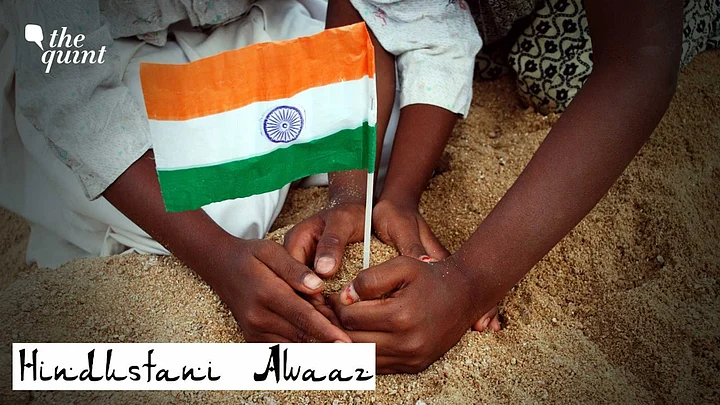The Har Ghar Tiranga campaign aspires to bring the national flag, literally, into every Indian home. But the tiranga has seldom been absent from our thoughts; if anything, love for the tiranga has been hiding in plain sight in a great deal of poetry, specifically Urdu poetry.
Virtually from the day it was first hoisted, the poet has written paeans in its praise, invoking the many sacrifices of countless Indian men and women that made possible its first unfurling in Free India, citing the hopes and aspirations of a fledgling nation that it embodies.
'Shaan, Nirala, Azmat': The Many Adjectives for the Indian Flag
Among the most-often used adjectives to describe the dhwaj, a word that defies easy translation and goes way beyond the English equivalent for ‘appearance,’ are shaan (splendour or style), nirala (unique), and azmat (glory), making the tiranga a veritable embodiment of peace and harmony (amn-o-aman ka paikar), a lasting symbol of freedom (azadi ki nishani) and a symbol of national identity (Bharat ki pehchan).
Shamim Karhani, who wrote many a qaumi geet (nationalistic song) in the early years of independence, also penned a beautiful poem on the tiranga, likening the saffron in it to the colour of ripe mangoes, the white to pristine snows on the Himalayas and the green to the tender saplings growing in the fields of rural India:
Jan-bazon ke paak lahu ki yaad dilane wali
Jangal ki ankhon ki surat sabz hai teri dhari
Jaise dhaan ki pahli konpal sundar komal pyari
Aur Ashoka chakr mein amn-o-rahat ka ujyala
(Reminding us of the pure blood of the brave-hearts
The green border is like the green eyes of the forests
And as lovely as the first green shoot of tender paddy
With the Ashoka Chakra embodying the light of peace)
'Even the Mighty Himalayas Bow Its Head Before Tiranga'
Vaqar Khaleel, the poet from Hyderabad in a long poem on the Tricolour, says such indeed is its majesty that even the mighty Himalayas bow its head before it (uncha jo hai Himala woh bhi to sar jhukaya):
Amn-o-aman ki rangat viron ke ḳhuun ki laali
Iss mein jhalak rahi hai mazdur ki bahali
(The colours of peace, the red of the martyrs’ blood
Reflects here and the better days awaiting the workers)
Saadat Nazeer writes:
Sachchai aur dharam ka mazhar
Chaand sitaare sadqe tujh par
(A testament of truth and righteousness
The moon and stars offer themselves as sacrifice to you)
Others have written of the fluttering tricolour that fills the air with peace, harmony and goodwill, the frisson of deeply-felt emotions that are excited upon spotting it. For Masooda Hayat, the flag embodies what it means to be an Indian:
Jhanda hi tauqir-e-watan hai
Jhanda hi tasvir-e-watan hai
Jhanda hi taqdir-e-watan hai
(The flag is the honour of the nation
The flag is the portrait of the nation
The flag is the destiny of the nation)
Tricolour Belongs to All Indians and Not a Chosen Few
Many poets have written nationalistic poems, especially for children; of these Shafiuddin Nayyar has written some of the sweetest, such as 'Jhanda uncha rahe hamara,' which uses words a mother might for her child so brimful it is with a pure, unadulterated love while also stressing that the Tricolour belongs to all Indians, and not a chosen few:
Sab se achchha sab se nyara
Rang tiranga pyara pyara
Qaum ki ummidon ka sahara
Des dulara jag ujyara
Dil ki thandak aankh ka taara …
Des disa dikhlane wala
Hosh mein hum ko laane wala
Josh se dil garmane wala Khidmat par uksane wala
Qaum ki nayya khaivan hara …
Jab jhanda lahraega yeh
Man ki jot jagaega yeh
Apnaiyat phailaega yeh
Preet ki reet sikhaega yeh
Prem ka sagar prem ki dhara
(The loveliest and fairest of all
The dearly beloved Tricolour
This prop for the nation’s hopes
The nations’ darling, beacon for the world
Gives comfort to the heart, this light of our eyes
It gives direction to the country
It brings us back to our senses
It warms our heart with passion
It rouses us to service and duty
It is the rower of the nation’s boat
When this flag flutters in the wind
It lights the lamp of our heart
It spreads a sense of belonging
It will teach us the habit of loving
For it’s an ocean of love, a stream of love)
PS: I am no a poet and can, at best, rely on simple words to relay first-hand, truly-felt emotions. I have never felt prouder to be an Indian nor closer to tears upon sighting the Indian flag than I did while performing the Haj in 2012. As a Guest of Allah – one of over 3 billion people who come to the Baitullah, the Holiest of Homes for the annual Haj – the entire experience was a humbling one.
To be a tiny speck in the vast ocean of humanity from the far-flung corners of the Muslim world is an overwhelming feeling and yet in the midst of it all, I could feel my heart swell with pride upon spotting the Indian Tricolour fluttering tall at the camps for Indian Hajis at Mina and Arafat.
That rush of emotions at the sight of the tiranga, thousands of kilometres away from home and country, is among my most cherished memories.
(Dr Rakhshanda Jalil is a writer, translator, and literary historian. She writes on literature, culture, and society. She runs Hindustani Awaaz, an organisation devoted to the popularisation of Urdu literature. She tweets at @RakhshandaJalil. This is an opinion piece and the views expressed above are the author’s own. The Quint neither endorses nor is responsible for the same.)
